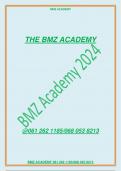BMZ ACADEMY
THE BMZ ACADEMY
@061 262 1185/068 053 8213
BMZ ACADEMY 061 262 1185/068 053 8213
, BMZ ACADEMY
Table of Contents
Question 1 ............................................................................................................... 3
Question 2 ............................................................................................................... 4
2.1 Type of Strike .................................................................................................. 4
2.2 Analysis of the Legality of the Workers' Strike and Dismissals ............................. 4
Question 3 ............................................................................................................... 6
3.1 Barriers to Effective Communication ................................................................ 6
3.2 Type of Participation ........................................................................................ 7
3.3 Competition and Power Play Between Groups and Its Negative Implications ....... 7
Question 4 ............................................................................................................... 9
4.1.1 Specialization .............................................................................................. 9
4.1.2 Centralization and Decentralization ............................................................... 9
4.2 Employment Relations Strategy at Makelotsomoney ........................................ 10
Question 5 ............................................................................................................. 11
5.1.1 Possible Causes/Sources of the Conflict ...................................................... 11
5.1.2 Type and Level of the Conflict ................................................................ 12
5.1.3 Stage of the Conflict ................................................................................... 12
5.2 Type of Team the Managers Form ............................................................... 12
References ............................................................................................................ 14
BMZ ACADEMY 061 262 1185/068 053 8213
, BMZ ACADEMY
Question 1
Understanding the rights and obligations of both employers and employees is
essential in employment interactions, especially when disagreements emerge around
job expectations and recognition. In light of the Labour Relations Act (LRA), this
research looks at the fairness of Joe and Frank's termination as well as the legality of
their reluctance to utilise computers. Through this assessment, we may learn more
about the standards for a just dismissal and take into account workable options that
Joe and Frank could have used to resolve their issues. The Labour Relations Act (LRA)
outlines specific conditions regarding employee misconduct and insubordination, both
of which relate to the situation involving Joe and Frank. According to Section 188 of
the LRA, a dismissal is only considered fair if it is based on a fair reason and followed
by a fair procedure (Grogan, 2019).
Legality of Refusal to Use Computers
To get regrading, Joe and Frank protested by refusing to use the computers they had
previously learnt how to use. According to the LRA, insubordination occurs when an
employee disregards reasonable directives from their employer (Basson et al., 2019).
Given the store's technological upgrading, using a computer was a legitimate job
requirement; hence, the denial was considered insubordination. For instance, in a
comparable retail setting, if staff members are requested to adopt a new sales
monitoring program to improve efficiency, their denial on the grounds of demands for
regrading would probably also be considered insubordinate.
Fairness of Dismissals
Joe and Frank’s dismissal can be examined against the LRA’s criteria for fair
dismissals, which include conduct, capacity, and operational requirements (Grogan,
2019). To establish whether their dismissal was fair, there is need for the following.
Procedural Fairness: They were issued multiple warnings, which aligns with the
procedural requirements for dismissal based on misconduct.
Substantive Fairness: Their repeated refusal to use the computers hindered
company operations, justifying the dismissal from a substantive fairness perspective,
especially after alternative measures like oral and written warnings were exhausted.
For example, in many companies, employees who repeatedly ignore procedural
BMZ ACADEMY 061 262 1185/068 053 8213





